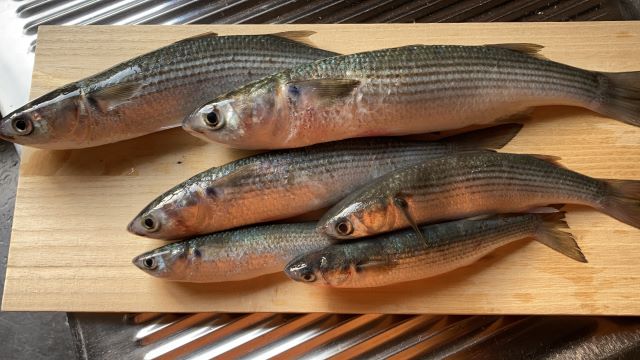
The appearance of Striped mullet (Bora)
Common name: Striped mullet, Flathead gray mullet, Sea mullet, River mullet, Common grey mullet, Black mullet, Bright mullet, Black true mullet, Bully mullet, Callifaver mullet, Haarder, Hardgut mullet, Callifaver mullet, Common mullet, Common striped mullet, Fatback, Flathead mullet, Hardgut mullet, Jumper, Jumping mullet, Mangrove mullet, Poddy mullet, Sand mullet, Springer, True mullet
Japanese name: Bora (鯔、母羅)
Taiwan common name: 鯔、青頭仔 (幼魚)、奇目仔 (成魚)、信魚、正烏、烏魚、正頭烏、回頭烏、大烏 (澎湖)
Chinese common name: 鲻
Korean common name: 숭어
French common name: Cabot
Italian common name: Baldigare, Bolpina, Capazzone, Capocefalo
Spanish common name: Albur, Bullûa, Cabezudo, Cabeçut, Cachamba, Cap pla, Capiton, Capitán
Portuguese common name: Cagarraz, Cambiro
Scientific name: Mugil cephalus Linnaeus, 1758
Nigiri sushi detail: Striped mullet (Bora) Nigiri sushi
Remarks:
Striped mullet (Bora) is widely distributed throughout Japan south of Hokkaido, and along the coasts of temperate and tropical regions of the world, except from West Africa to the coast of Morocco. It is also found in estuaries and freshwater areas, and young fish migrate up to the middle reaches of rivers. The body length is about 80 cm, and the shape is a rounded, elongated cylinder. Its body color is blue-black on the back and silvery-white on the belly.
Bora has similar flesh to Aji, but it does not have the umami of Aji, nor does it have the light flavor of Tobiuo. Moreover, since it is abundant and found in inner bays, it has an odor depending on the location. It also has a strong smell in some places, and this smell can be even stronger in seasons other than winter. It is said that to taste it, it is best to eat it chilled in icy water (Arai), so no matter how Ikejime it is, it is difficult to say that it tastes good as a sushi topping.
Ovaries are the raw material for Karasumi. It can be caught all over Japan, but large, ripe ovaries are scarce, and Karasumi is sold at a high price.
Share this article